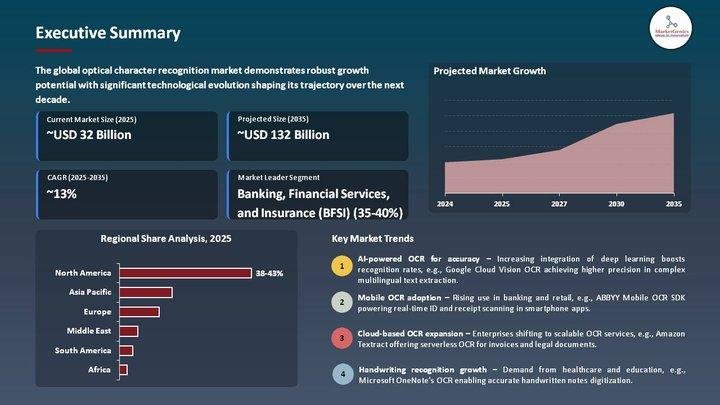
Optical Character Recognition Market to Reach USD 131.9 Billion by 2035, Creating USD 99.5 Billion in New Opportunities Driven by
The global Optical Character Recognition (OCR) Market is projected to grow from USD 32.4 billion in 2025 to USD 131.9 billion by 2035, expanding at a CAGR of 13.6% during the forecast period.
This surge in demand is driven by the large-scale shift toward AI-enhanced document processing, mobile-first banking workflows, and intelligent automation across BFSI, healthcare, logistics, and government digitalization initiatives.
MarketGenics identifies OCR as a foundational automation layer enabling enterprise-wide digital transformation through rapid, secure, and multilingual data extraction at scale, reducing manual workloads and accelerating compliance-focused workflows.
Get the Detailed Industry Analysis (including the Table of Contents, List of Figures, and List of Tables) – from the Optical Character Recognition Market Research Report: https://marketgenics.co/press-releases/optical-character-recognition-market-48457
Recent Developments Shaping the Market
Mobile OCR for Industrial Use Cases Gains Traction
In February 2025, Anyline GmbH launched an upgraded mobile OCR SDK tailored for logistics and automotive industries, offering offline OCR capabilities for VIN scanning, tire identification, and license plate recognition. This upgrade improves field-level speed and data privacy, positioning Anyline as an innovation leader in sector-specific OCR deployments.
Advancements in High-Accuracy Intelligent OCR
ABBYY introduced FineReader PDF 16 with enhanced AI capabilities to increase recognition precision across complex document layouts and multilingual content. The new functionality is accelerating adoption in industries such as law, healthcare, and government that depend on high-integrity documentation.
Developer-Centric OCR Platforms Expand Market Reach
In March 2025, a new generation OCR API was released with ~90% accuracy on multilingual and structurally complex documents. Offering SDKs for Python, C#, and TypeScript, it is designed for seamless integration into automation workflows and enterprise cloud environments.
Lightweight Academic Models Bring Efficiency to Handwriting Recognition
In April 2025, VISTA-OCR unveiled a lightweight 150M parameter academic model that delivers superior printed and handwritten text recognition with minimal compute overhead, enabling broader accessibility for low-latency industrial deployments.
Optical Character Recognition Market Forecast 2035
The OCR market is set to create USD 99.5 billion in incremental opportunity between 2025 and 2035.
• North America will remain the most attractive and mature market as enterprises scale AI-based document workflows across finance, healthcare, legal, and government systems.
• Asia-Pacific adoption will accelerate as ecommerce, fintech penetration, and digital infrastructure investments drive large-scale OCR integration.
• Europe will see continued growth supported by multilingual document processing mandates and regulatory digitalization.
• Emerging markets in the Middle East and South America are adopting OCR through mobile-first automation and cross-border ecommerce expansion.
By 2035, OCR will no longer function as a standalone recognition engine but as a core component of enterprise intelligent document workflows integrated with IDP, RPA, and AI-driven process orchestration.
To know more about the Optical Character Recognition Market – Download our Sample Report: https://marketgenics.co/download-report-sample/optical-character-recognition-market-48457
Key Drivers, Challenges, and Opportunities
Driver – Mobile Banking and Fintech Integration
The rapid rise of mobile-first financial services has turned OCR into a core authentication and compliance tool, automating identity verification, onboarding, check processing, and invoice parsing. Real-time extraction through mobile SDKs significantly reduces manual verification friction while improving speed and accuracy.
Restraint – Handwritten and Low-Quality Document Accuracy Gaps
Despite major advances, OCR systems still encounter limitations in processing handwritten or poorly scanned documents, especially in regulated industries like healthcare and legal services. Accuracy variability in non-standardized input formats delays full-scale automation and slows adoption in compliance-heavy environments.
Opportunity – Multilingual Processing for Cross-Border Digital Commerce
As ecommerce and logistics become increasingly global, OCR solutions supporting multi-script and multi-language inputs are seeing strong demand. Cross-border workflows are driving large-scale adoption among enterprises seeking automation in customs, billing, labeling, and distributed inventory documentation.
Key Trend – Evolution Toward Intelligent Document Understanding (IDU)
The market is undergoing a structural shift from character recognition toward Intelligent Document Understanding (IDU), where OCR engines combine AI, machine learning, and context modeling to not only extract text but also interpret meaning, structure, and document intent. This transformation is enabling high-value use cases such as claims automation, contract intelligence, and compliance monitoring.
Segmental Insights
BFSI Sector Leads with ~37% Share
The Banking, Financial Services, and Insurance segment holds approximately 37% of the global market due to its heavy reliance on automated KYC, regulatory documentation, claims processing, and onboarding workflows. OCR is now embedded as a core layer in digital banking infrastructure.
Buy Now: https://marketgenics.co/buy/optical-character-recognition-market-48457
Regional Highlights
North America dominates the global OCR market due to mature IT infrastructure, large-scale automation initiatives, AI-based compliance systems, and strong adoption across financial institutions, healthcare providers, and public sector agencies. Early investment in enterprise-grade AI platforms further accelerates innovation cycles in the region.
Competitive Landscape
The OCR market is moderately fragmented, with Tier 1 companies such as ABBYY, Adobe, Google, Microsoft, and Kofax leading through enterprise-grade innovation and global deployments. Tier 2 players like Anyline specialize in lightweight, mobile-first OCR solutions tailored for industry-specific use cases, while a wider ecosystem of cloud and automation vendors drives integration at scale.
Future Outlook
By 2035, OCR will evolve into a cognitive automation backbone, deeply embedded across enterprise data infrastructures. Integration with intelligent document processing, automation workflows, and multilingual AI will transform OCR from a recognition layer into a decision-enabling technology powering regulatory compliance, financial infrastructure, cross-border commerce automation, and large-scale digital transformation in data-intensive industries.
Get a preview of our Optical Character Recognition Market Playbook – your guide to GTM strategy, competitive intelligence, supplier dynamics, and Consumer Behavior Analysis: https://marketgenics.co/playbook/optical-character-recognition-market-48457
Prominent Companies Operating in the Global Optical Character Recognition Market:
ABBYY, Adobe Inc., Google LLC, Microsoft Corporation, Kofax Inc., Anyline GmbH, and other key players.
About Us
MarketGenics is a global market research and management consulting company empowering decision makers across healthcare, technology, and policy domains. Our mission is to deliver granular market intelligence combined with strategic foresight to accelerate sustainable growth.
We support clients across strategy development, product innovation, healthcare infrastructure, and digital transformation.
Contact:
Mr. Debashish Roy
MarketGenics India Pvt. Ltd.
800 N King Street, Suite 304 #4208, Wilmington, DE 19801, United States
USA: +1 (302) 303-2617
Email: sales@marketgenics.co
Website: https://marketgenics.co
This release was published on openPR.












